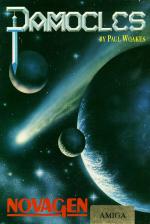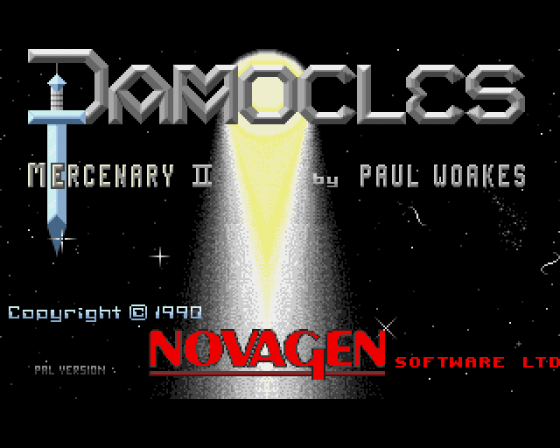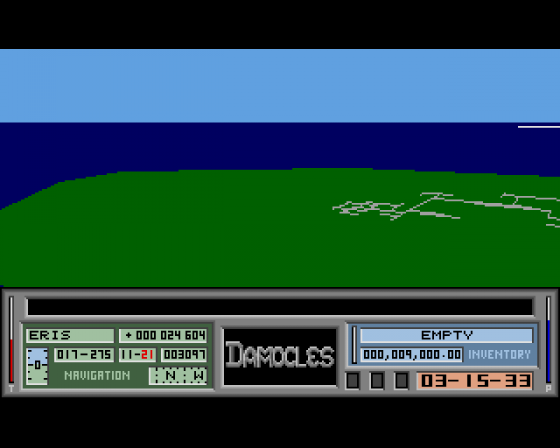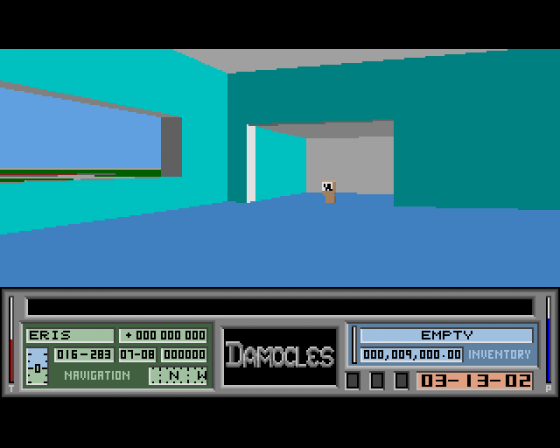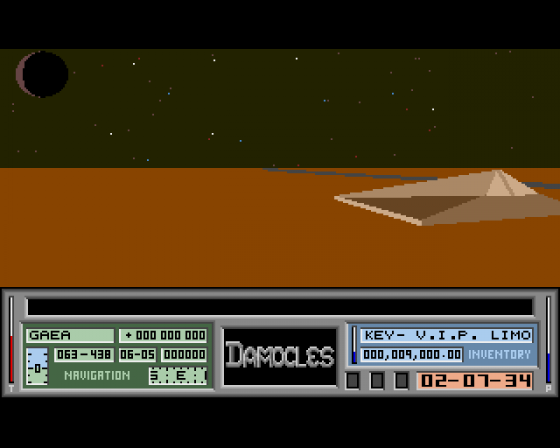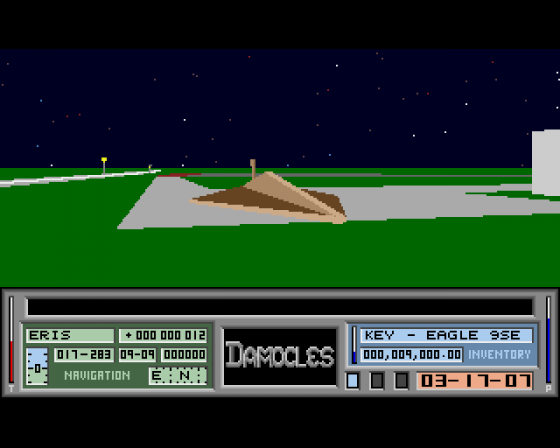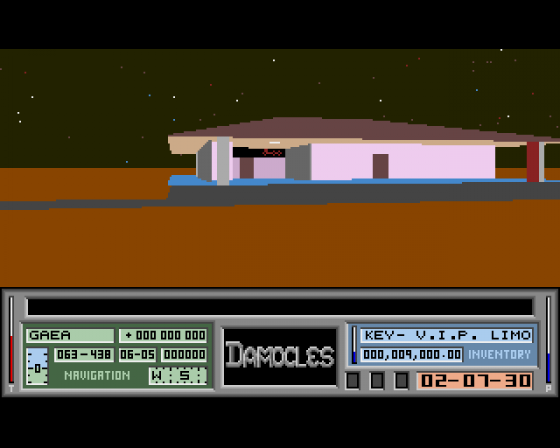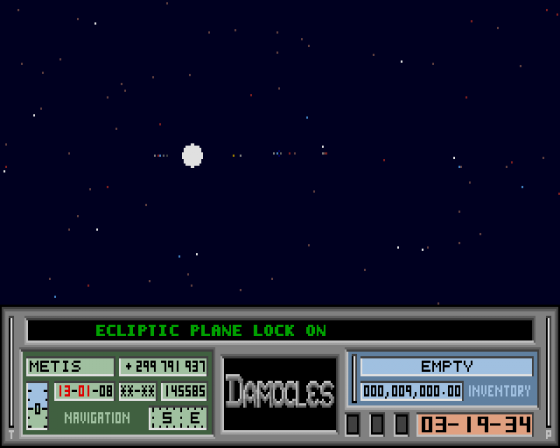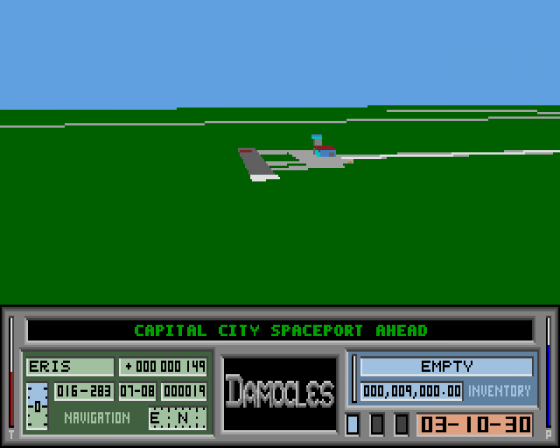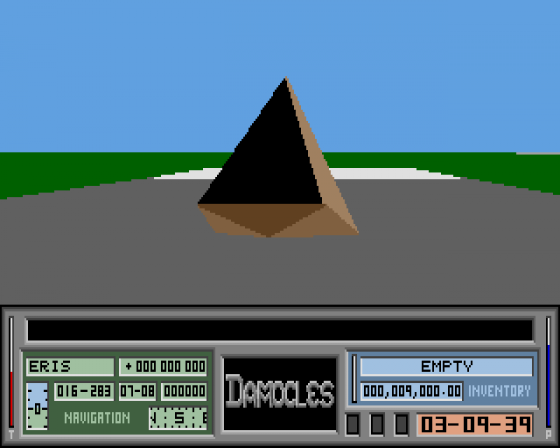Damocles
When the sun Dialis slips out of sight on the far side of the planet Eris - an unsuspecting Erisian could be forgiven for believing that all was well with the universe - such is the beauty of the spectacle. The Oceanic world of Eris is populated by nine islands with the inhabitants living in single city states. Almost all of its surface is water - making it glow like a giant sapphire as it resides in the fifth position in the Gamma Galaxy. But a catastrophe is about to befall Eris. The comet Damocles is hurtling towards it and will collide in a few short hours unless you can prevent it from doing so. But how?
Damocles is the sequel to the classic Mercenary - in which the player had to escape from the planet Targ. Damocles takes up the story after the player has succeeded in completing all the tasks and earned enough to purchase a ship to escape from Targ. You can enter this achievement, and anything you brought with you from Targ, into the sequel and continue with the adventure. If not, don't worry, as the game stands alone.
One thing Mercenary veterans will be ecstatic about is that Benson is back. Benson is a Ninth Generation PC, a helmet-mounted computer, who soon becomes more of a companion than a mere computer as you explore the nine planets and the nineteen moons that surround the star Dialis. Benson has a wry wit, but is no mere joker as he will provide you with lots of clues as to where to find certain objects that you will need to complete the mission.
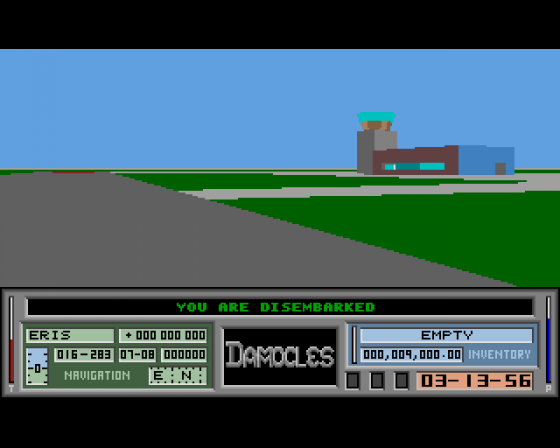
Although, superficially, Damocles resembles the Amiga version of Mercenary - in the gameplay department it is very much more sophisticated. This has been greatly improved by the control you have over the objects that you can collect. You can actually use them to carry out tasks - rather than just placing them in the current location, as you did in Mercenary. When you select an item it appears in the Damocles window at the centre of the control panel - together with instructions on how to use it. Novagen are not giving much away about these objects, as their selection and use is central to the main task of stopping that comet - by whatever method you can. One of the items, however, is the camera. One of the neatest bits of deign that this increasingly popular type of Amiga game has seen in a long time. You can control certain objects remotely. This means if you cannot prevent the comet crashing into Eris - stick a camera on one of its moons and watch the fireworks. Similarly, if there is anything else you want to keep an eye on - you should go get the camera and set it up. A spin-off benefit that has resulted from the work that went into developing the camera is that you can also take remote control of the ship. There is no major benefit in terms of the overall objective of the game - but it sure is fun. Fly around buildings - under bridges - take a few pops at things, it makes for excellent light relief from the main business of attempting to prevent the demise of Eris. You can take remote control of the various land vehicles - speeding down the road networks in the Damocles cities. Again, not quite in the Continental Circus league - but as incidental entertainment it is unrivalled.
Intelligent life is found on all of the planets in the Gamma Solar System - and you will have to visit them all, and explore all of the cities, searching buildings for useful objects if you are to save Eris. Again these structures represent another great improvement on Mercenary. Many of them are vast, like the Space Station, Parliament building, Lawson's Bank (I kid you not, they charge 15% interest), or Hathaway's Wine Bar. A map room will provide useful information on getting around them, but it doesn't tell you everything, and there is lots of good ol' exploring for you to do. One of the neatest buildings is the shop where you can place an item in the shop window, walk out of the shop, around to the front and see that same object exactly where you left it in the window. Knowing the value of commodities is crucial in Damocles, as trading is just as vital to success as it was in Mercenary. Don't expect to find everything you need - some things have to be paid for in hard cash.
A good deal of puzzling is required to destroy the comet - as is a close eye on the various timer controls. There is a lot to do to win, and not an awful lot of time in which to do it. A good deal of thought has gone into the timing in Damocles - which adds to the overall feel of the challenge. Novagen have weighted the various speeds of travel (near-light speed between planets) against the real-time clock which is ticking down all the time the game plays. Real time on the control planet clock represents the time left before the comet crashes into Eris. Just a few short hours. This doesn't mean you have to play the game for hours on end. There is a useful quit game and save option to let you pause and then restart whenever you like.
The heart of the gameplay in Damocles is in the puzzle element - the challenge of trying to prevent the catastrophe. Just as in Mercenary, any player worth his salt won't want to quit until they have escaped from Targ. The same is true of Damocles - but again, just like Mercenary, there is stacks of fun to be had along the way, in exploring, using objects and travelling through the graphically delightful Gamma Solar System. The sunsets on a variety of planets are splendid - and as well as this they are all performing mathematically accurate in terms of their geographical relationships to each other. This all contributes to creating a world which is entirely plausible from whichever angle you choose to explore it. Sure, this has been done before - in things like Dark Side and, to a lesser extent in Star Glider II, but it has not yet been done as well.
Amiga gaming at its very best.


 1st November 1989
1st November 1989